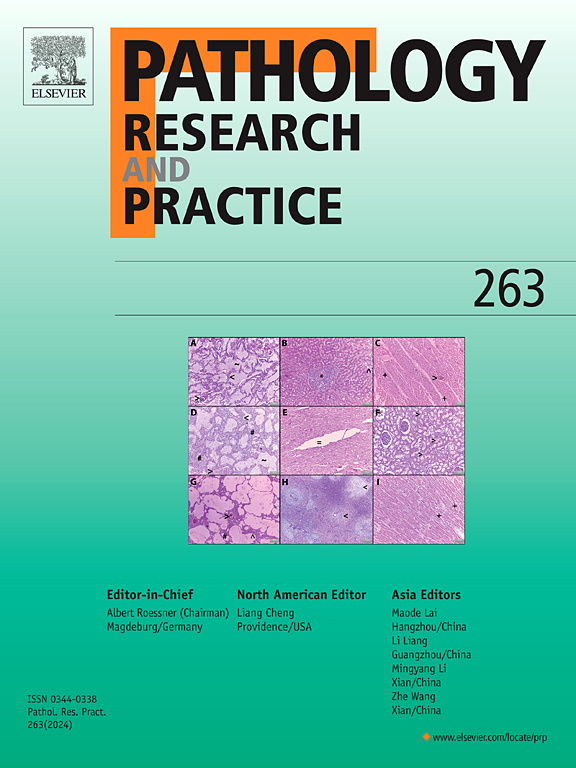CD66b+肿瘤相关中性粒细胞在新辅助治疗的化生和非化生三阴性乳腺癌中的数量和空间分布特征及其预后意义
IF 3.2
4区 医学
Q2 PATHOLOGY
引用次数: 0
摘要
目的本研究旨在比较新辅助化疗(NACT)前化生性乳腺癌(MpBC)和非化生性三阴性乳腺癌(TNBC)患者肿瘤相关中性粒细胞(TANs)的密度和空间分布,以确定预后生物标志物和治疗意义。方法回顾性分析三家医院接受NACT治疗的MpBC和非化脓性TNBC患者。使用基于人工智能(AI)的阳性细胞分类器对CD66b+ TANs进行量化和空间映射。比较两组患者的临床病理特征。统计分析评估TANs的预后价值及其在NACT中的预测价值。结果MpBC与非化生TNBC患者在年龄、肿瘤大小、Ki-67表达、残留癌负担分级、病理完全缓解(pCR)率、无病生存(DFS)、CD66b+ TAN密度、空间分布等方面存在显著差异。没有MpBC患者实现pCR,而30.8% %的非化脓性TNBC患者实现了pCR。在MpBC中,较大的肿瘤大小和基质为主的CD66b+ TAN分布与较差的预后相关。在非化生的TNBC中,肿瘤大小>; 2 cm、雄激素受体阳性和高CD66b+ TAN密度与较低的pCR率相关,而肿瘤大小>; 2 cm、淋巴结阳性和CD66b+ TAN密度升高与较差的DFS相关。结论cd66b + TANs可能是NACT术后MpBC和非化生TNBC的潜在预后生物标志物,其密度和空间分布也有助于了解患者的预后。本文章由计算机程序翻译,如有差异,请以英文原文为准。
Quantitative and spatial distribution characteristics of CD66b+ tumor-associated neutrophils in metaplastic and non-metaplastic triple-negative breast cancer treated with neoadjuvant therapy and their prognostic significance
Purpose
This study aimed to compare the density and spatial distribution of tumor-associated neutrophils (TANs) in metaplastic breast cancer (MpBC) and non-metaplastic triple-negative breast cancer (TNBC) patients before neoadjuvant chemotherapy (NACT) to identify prognostic biomarkers and therapeutic implications.
Methods
We conducted a retrospective analysis of patients with MpBC and non-metaplastic TNBC both treated with NACT from three hospitals. CD66b+ TANs were quantified and spatially mapped using an artificial intelligence (AI) -based positive cell classifier. Clinicopathological characteristics were compared between the two groups. Statistical analyses were used to assess the prognostic value of TANs and their predictive value in NACT.
Results
Significant differences were observed between MpBC and non-metaplastic TNBC patients in age, tumor size, Ki-67 expression, residual cancer burden grade, pathologic complete remission (pCR) rate, disease-free survival (DFS), CD66b+ TAN density, and spatial distribution. No MpBC patients achieved pCR, whereas 30.8 % of non-metaplastic TNBC patients did. In MpBC, larger tumor size and stromal-predominant CD66b+ TAN distribution were associated with poorer prognosis. In non-metaplastic TNBC, tumor size > 2 cm, androgen receptor positivity, and high CD66b+ TAN density correlated with lower pCR rates, while tumor size > 2 cm, lymph node positivity, and elevated CD66b+ TAN density were linked to worse DFS.
Conclusion
CD66b+ TANs might serve as a potential prognostic biomarker in MpBC and non-metaplastic TNBC following NACT, and their density and spatial distribution also contributed insights into the prognosis of the patients.
求助全文
通过发布文献求助,成功后即可免费获取论文全文。
去求助
来源期刊
CiteScore
5.00
自引率
3.60%
发文量
405
审稿时长
24 days
期刊介绍:
Pathology, Research and Practice provides accessible coverage of the most recent developments across the entire field of pathology: Reviews focus on recent progress in pathology, while Comments look at interesting current problems and at hypotheses for future developments in pathology. Original Papers present novel findings on all aspects of general, anatomic and molecular pathology. Rapid Communications inform readers on preliminary findings that may be relevant for further studies and need to be communicated quickly. Teaching Cases look at new aspects or special diagnostic problems of diseases and at case reports relevant for the pathologist''s practice.

 求助内容:
求助内容: 应助结果提醒方式:
应助结果提醒方式:


